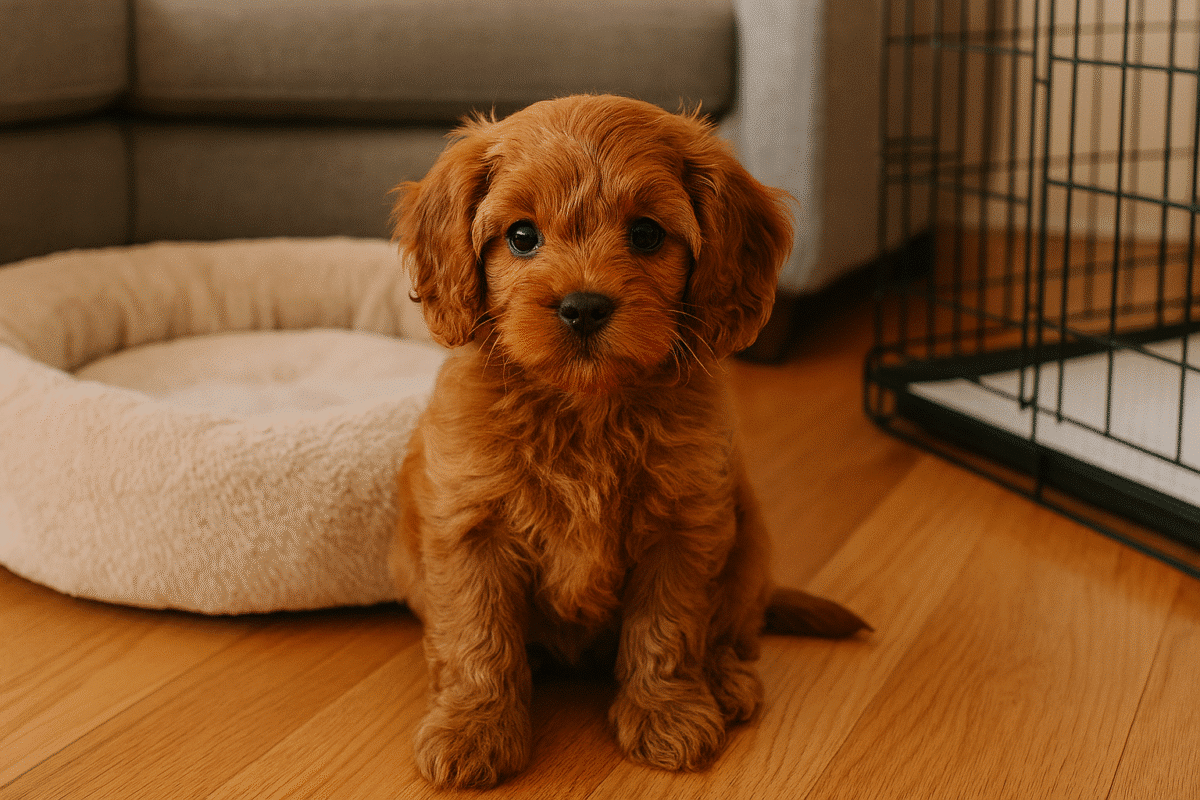Puppy Guide
How to Prepare for a Cavoodle Puppy: Your Complete Family Guide
Cavoodles are quickly becoming one of Australia’s most beloved dog breeds — and it’s easy to see why. With their teddy bear looks, affectionate nature, and low-shedding coats, these adorable pups are a perfect fit for families, singles, and retirees alike. But before you welcome your new best mate into your home, it’s essential to prepare your space, your schedule, and your mindset for the exciting journey ahead.
Whether you’re a first-time dog owner or adding to your pack, this guide will help you confidently prepare for your Cavoodle puppy’s arrival — ensuring a safe, happy, and healthy start.
Creating a Safe and Puppy-Proof Home
Puppies are naturally curious and love to explore their surroundings — often with their mouths! That’s why puppy-proofing your home is one of the first and most important steps.
Inside the Home:
- Secure electrical cords with cord covers or hide them behind furniture to prevent chewing.
- Remove small objects like coins, buttons, and children’s toys that could be swallowed.
- Install baby gates to block off stairs or rooms that are off-limits.
- Keep cleaning products, medications, and sharp objects in locked cupboards or high shelves.
- Use pet-safe cleaning products to avoid toxic exposure (RSPCA Australia, 2023).
In the Garden:
- Check fencing for gaps or holes — Cavoodles are small and can squeeze through tight spaces.
- Remove toxic plants such as lilies, azaleas, and sago palms. These are harmful if ingested (RSPCA Knowledgebase, 2023).
- Secure bins, tools, and chemicals to prevent accidents.
Must-Have Puppy Essentials
Before your Cavoodle arrives, make sure you have the right gear to keep them comfortable, safe, and happy.
- 🛏️ Comfortable Bed: Choose a soft, washable bed that’s the right size for a small breed.
- 🏠 Crate: A crate provides a secure space for your puppy to rest and is a powerful tool for toilet training. It should be large enough for your puppy to stand, turn, and lie down comfortably (RSPCA Australia, 2023).
- 🧻 Pee Pads: Useful for early toilet training, especially if your puppy isn’t fully vaccinated yet.
- 🍽️ Food & Water Bowls: Stainless steel or ceramic bowls are hygienic and easy to clean.
- 🐾 Collar, Lead & ID Tag: Ensure your puppy is identifiable and safe when out and about.
- 🧸 Toys: Include chew toys, puzzle toys, and soft toys to keep your puppy mentally stimulated and entertained.
- 🧼 Grooming Supplies: Cavoodles need regular grooming. Invest in a slicker brush, puppy shampoo, nail clippers, and ear-cleaning solution.
- 🐶 High-Quality Puppy Food: Choose a premium brand formulated for small breed puppies. Look for products that meet AAFCO standards and are recommended by your vet (Pet Food Industry Association of Australia, 2023).
Establishing a Routine: Sleep, Play & Toilet Training
Cavoodles thrive on structure. A consistent daily routine helps your puppy feel secure and supports successful training.
Sample Daily Schedule:
- 7:00 AM – Wake up and toilet break
- 7:30 AM – Breakfast
- 8:00 AM – Playtime and short walk
- 9:00 AM – Toilet break and Nap time
- 10:30 AM – Toilet break then quiet play or crate rest
- 12:00 PM – Toilet break and lunch
- 1:30 PM – Toilet break then quiet play or crate rest
- 3:00 PM – Toilet break then Playtime and short training session
- 5:00 PM – Dinner
- 5:30 PM – Toilet break
- 6:00 PM – Gentle walk or play
- 8:00 PM – Toilet break then Wind-down time
- 9:00 PM – Final toilet break and bedtime
Sleep Needs:
Puppies need 18–20 hours of sleep per day to support their rapid physical and mental development (Australian Veterinary Association, 2023). Make sure your Cavoodle has a quiet, comfortable space to rest.
Play & Exercise:
Cavoodles are energetic and intelligent. Short, frequent play sessions and gentle walks are ideal. Avoid over-exercising young puppies, as their joints are still developing. A good rule of thumb is 5 minutes of exercise per month of age, up to twice a day (Petbarn, 2023).
Feeding Your Cavoodle Puppy
Nutrition plays a vital role in your puppy’s growth and wellbeing. Cavoodles are small dogs, so they benefit from food designed for small breeds.
What to Feed:
- Choose a premium puppy food with high-quality protein (e.g., chicken, lamb, or fish).
- Look for formulas with DHA for brain and eye development.
- Avoid foods with artificial colours, flavours, or preservatives.
Feeding Schedule:
- 8–12 weeks: 4 meals per day
- 3–6 months: 3 meals per day
- 6–12 months: 2 meals per day
Always provide fresh, clean water and consult your vet for tailored advice. For more on feeding puppies, see the RSPCA Knowledgebase.
Starting Obedience Training Early
Cavoodles are known for their intelligence and eagerness to please, making them ideal candidates for early training.
When to Begin:
- Start basic training and socialisation from 8 weeks of age (Australian Veterinary Association, 2023).
- Focus on commands like sit, stay, come, and leave it.
- Use positive reinforcement — reward good behaviour with treats, praise, or play.
- Enrol in a puppy preschool around 10–12 weeks to help with socialisation and basic obedience (RSPCA Australia, 2023).
Final Thoughts
Welcoming a Cavoodle puppy into your home is a joyful and life-changing experience. With the right preparation, you’ll create a safe, loving environment where your puppy can thrive. From puppy-proofing your home to setting routines and starting training early, every step you take now lays the foundation for a happy, well-adjusted dog.
For more expert tips, product reviews, and community stories, visit Woof Spark — your trusted guide to raising happy, healthy dogs.


